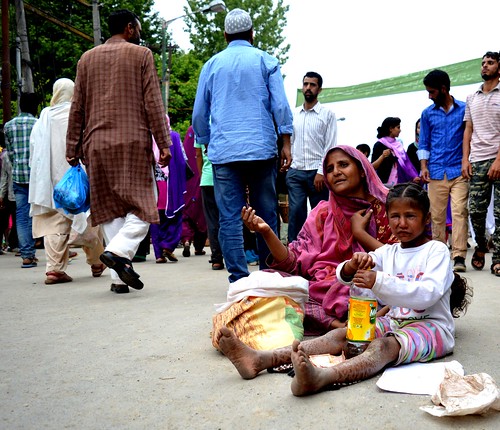By Bilal Bashir Bhat
Srinagar: With the ongoing peak tourist season in Kashmir and the sacred month of Ramadan, a number of non-local beggars have rushed to the Valley. Possibly, they are being counted as tourists but factually it is the season for them to earn big.
Every year hundreds and hundreds of beggars from outside the state throng the Valley as soon as the tourist season begins. The number of non-local beggars is too high and they are seen mostly at tourist places, mosques, shrines, bus stands and traffic signals. A majority of them have set up colonies of tents on the outskirts and then roam in the lanes of Srinagar for alms.

For Representational Purpose Only (Photo by : Raqib Hameed Naik)
They army of such people usually come in the month of April and leave the valley in the month of October/November. Irrespective of age and sex, they are all engaged in begging. Little children can be seen begging along with their elders. Women with newly born infants are everywhere moving around the people with begging bowls.
‘Aap kay bachche Allah ki hifazat main rahein’ (May Allah protect your children from harm); ‘Allah aap ko aapke bachchon ki bahaar dikhayey’ (May Allah grant the dreams you have cherished for your children) – these are some of the pleas the child beggars approach the residents with.
Ironically, most of the child beggars who come here with their parents are registered as “tourists” since technically they are annual summer visitors to Kashmir. They leave the valley with the first snowfall each year.
The story is not restricted to only the non-local beggars, the valley has also its own army of beggars. It has been observed a majority of the old aged people residing of the rural areas are associated with pan-handling practice in Srinagar. The local beggars can only be seen outside the shrines and begging door to door.
At Sheikh Hamza Makhdoomi (R) shine in old city, there are about 200 beggars regularly for past many years. They have now permanent places for begging at the stairs of the shrine.
In some cases, male of the family goes for some manual work while female and children move for begging because begging is more profitable and less hard working for them.
According to a survey, conducted by a local daily ‘Precious Kashmir,’ due to police fear, male beggars usually prefer to remain away from the city and prefer begging in small towns while female beggars are seen sitting outside Masjids and shrines of the city in large numbers.
During the month of Ramadan, Kashmir witnesses a bloom of local and non-local beggars, as they flock to take advantage of the generosity of Muslims. In this holy month, Muslims give away a part of their earnings as charity to the poor and needy people.
Shopkeepers around the city centre, Lal Chowk, blame the authorities for their failure to curb the growing menace in spite of being sufficiently armed with laws, which they argue affect their business, as the beggars particularly the “non-locals” seen roaming around shops irks the customers.

